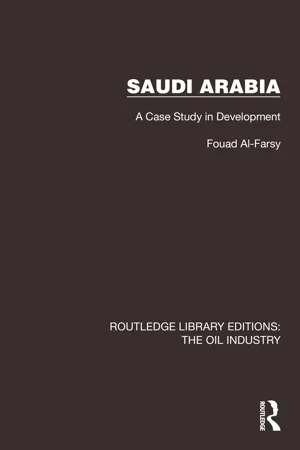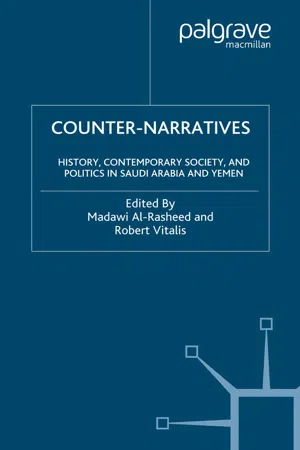History
America and Saudi Arabia
The relationship between America and Saudi Arabia has been characterized by strategic cooperation, particularly in the realms of energy, security, and geopolitics. This partnership has evolved over time, with the United States providing military support and economic aid to Saudi Arabia, while also benefiting from the kingdom's oil reserves. However, this alliance has also faced scrutiny due to human rights concerns and regional conflicts.
Written by Perlego with AI-assistance
Related key terms
1 of 5
3 Key excerpts on "America and Saudi Arabia"
- eBook - ePub
Saudi Arabia
A Case Study in Development
- Fouad Al-Farsy(Author)
- 2023(Publication Date)
- Routledge(Publisher)
Something similar, though not identical, happened in the United States. In its early years, almost everybody had one thing in common: their religion. Moreover, in many colonies a religious perspective was a significant part of the culture. One could say that, in terms of their overall cultural philosophy and orientation, Americans were originally religious people, though not necessarily in terms of the practice of religion. Early leaders did not always practice religion or attend church regularly, but they thought of themselves as Christians. Briefly, a general belief in Christianity was and is the American consensus over religion. The American people’s adherence to Judaeo-Christian ethics was influential in forming and solidifying the American nation of today.This chapter deals first with geographical considerations relating to the Kingdom of Saudi Arabia. The second part of this chapter will discuss Islam, its rise and its foundations, together with Wahhabism, in order to develop a better understanding of the Wahhabi movement. The third part will survey Saudi Arabian foreign relations with the Western Powers from 1915 through 1953. The fourth and final part will treat the consolidation of the Saudi nation by King Abdul Aziz Al Sa’ud through a period of more than twenty years since the king’s successful recapture of Riyadh in 1902.Since the contemporary period of Saudi Arabia along with the history of its petroleum are of great importance, they will be dealt with in detail in the following chapter.Geographical Considerations
The Kingdom of Saudi Arabia encompasses about four-fifths of the Arabian Peninsula. It had a population of just over seven million according to the census of 1974, a figure estimated to have risen by one million, including the immigrant workforce, by 1978. The Kingdom’s area is just over a million square miles, one-third the size of the United States of America. Saudi Arabia has a population density of six persons per square mile, a figure roughly comparable to the population density of the United States in 1790. The Kingdom is bounded on the north by Jordan, Iraq and Kuwait; on the east by the Gulf, Bahrain, Qatar and the United Arab Emirates (consisting of Abu-Dhabi, Dubai, Sharjah, Ras Al-Khaimah, Fujairah, Umm Al-Qawain and Ajman); on the south by the Sultanate of Oman and the two Yemeni Republics (North and South), and on the west by the Red Sea. Aside from the country’s religious and economic significance, “the potential importance of Saudi Arabia’s geographical position is quickly apparent: it is strategically located between Africa and mainland Asia, lies close to the Suez Canal and has frontiers on both the Red Sea and the Arabian Gulf.”2 - eBook - PDF
Counter-Narratives
History, Contemporary Society, and Politics in Saudi Arabia and Yemen
- M. Al-Rasheed, R. Vitalis, M. Al-Rasheed, R. Vitalis(Authors)
- 2004(Publication Date)
- Palgrave Macmillan(Publisher)
Chapter 7 The Capture of Riyadh Revisited: Shaping Historical Imagination in Saudi Arabia Madawi Al-Rasheed During the centennial celebrations, all talk was about the ‘liberation’ of Riyadh by Ibn Saud. One was led to imagine that the British or the French had been there. —Western Scholar: oral communication The Saudi state of 1932 is one of the new states of the Arab world born after the collapse of the Ottoman Empire following World War I. It dedicates large financial resources to historical research, publications, and dissemination of information about the past in an attempt to define its uniqueness as a national and political entity. 1 The state publishes history textbooks, encyclopedias, local chronicles, and archival material inside the country but mainly abroad. These are constantly reproduced, printed, and distributed. So far one of the main preoccupations of this vast literature is defining the key historical event that led to the birth of Saudi Arabia in the twentieth century. State sponsored historiography remains predominantly a history of the origins of the state, the role of important historical agents, and the material modernization of the country following the discovery of oil. This is an ideological history concerned with political legitimacy 2 rather than analytical interpretations of the past. Unfortunately, with few excep- tions, the majority of contemporary Saudi historians work in state institu- tions and academic research centers that militate against critical evaluation of the past. Most historical research is sponsored by the state. Since the 1970s oil wealth has allowed the state to increasingly dominate construc- tions and interpretations of the past. The state’s concern with its ideological history is neither unique nor exceptional. Saudi Arabia shares its desire to manipulate, glorify, and invent its past with other states not only in the Arab world but also elsewhere. - A. Rugh(Author)
- 2007(Publication Date)
- Palgrave Macmillan(Publisher)
CHAPTER 1 THE ECONOMIC AND POLITICAL CONTEXT History is a continuous chain of events. The present is only an extension of the past. He who does not know his past cannot make the best of his present and future, for it is from our past that we learn. —Shaikh Zaid D uring the twentieth century Middle Eastern tribal societies evolved into forms ranging from monarchies to republics. As they changed, they shared one feature—the tendency to concentrate power in a single ruler or president. In the fourteenth century, Ibn Khaldun (1967) wrote that it was in the nature of states to concentrate authority. Arab states in particular, he said, were founded on solidarities formed by the union of groups. When one group became more powerful than the rest, its leaders dominated other leaders. Variation in modern Arab states is not just due to leaders’ ability to dominate. Other factors including access to resources and the pressures brought about by external political and economic forces constrain their actions. Much has been written about British influence in the Gulf, the economic and political effects of tribal life, and about the discovery of oil. Important as these “external” events were in forming political structures, they constitute only one part of the story. Another part is the influence of less well-understood sociocultural factors affecting the way tribal leaders perceive their environments, and the relevance of options for meeting political challenges. Monarchy in England is not the same as monarchy in the Gulf, not so much because their institutional structures differ but because their people view the act of governing differently. We need to be careful though, not to assign too universal a framework to Arab worldviews. 2 Source: http://lcweb2.loc.gov/frd/cs/united_arab_emirates/ae05_01a.pdf Although similarities exist, views vary by geographic region, class, and time period, as well as within states.
Index pages curate the most relevant extracts from our library of academic textbooks. They’ve been created using an in-house natural language model (NLM), each adding context and meaning to key research topics.


